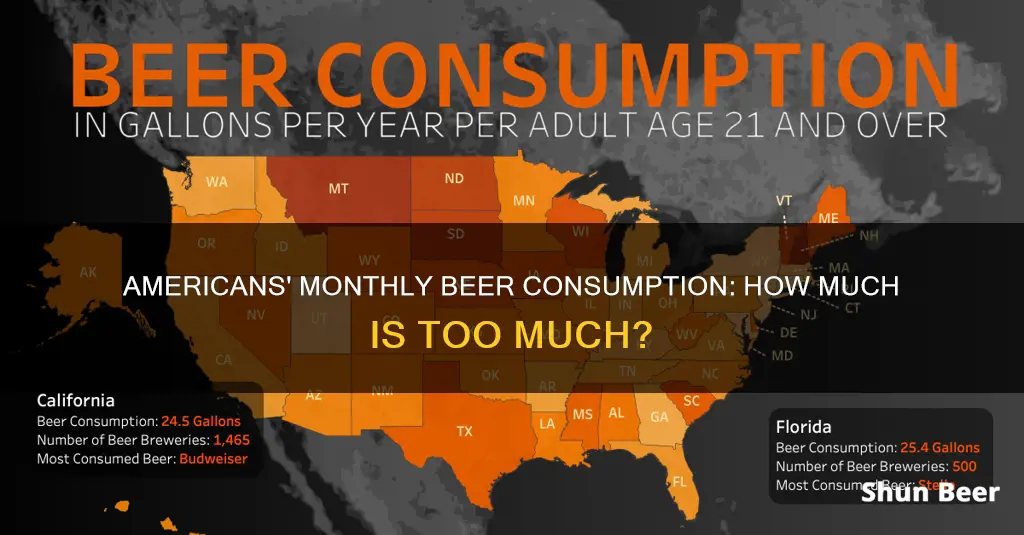
Alcohol consumption is a topic that has been widely studied and surveyed in the United States. Beer is the most popular alcoholic beverage among American drinkers, with 42% choosing it as their preferred drink. On average, Americans consume 28.2 gallons of beer per person per year, or about 10 ounces per day. This equates to roughly one six-pack per week for adults over the age of 21. Beer consumption patterns vary across the country, with residents of some states, such as North Dakota, New Hampshire, and Montana, consuming more beer than others. While the average amount of beer consumed by Americans provides a snapshot of drinking habits, it is important to distinguish between moderate and heavy drinking, with heavy drinking defined as consuming more than 14 drinks per week for men or more than 7 drinks per week for women.
| Characteristics | Values |
|---|---|
| Average beer consumption per adult (age 21 and over) per year | 28.2 gallons |
| Average beer consumption per drinking-age adult in 2018 | 26.2 gallons |
| Average daily consumption for adults over the age of 21 | 10 ounces |
| Average weekly consumption for adults over the age of 21 | One six-pack |
| Percentage of American adults who drink alcohol | 62% |
| Percentage of American drinkers who prefer beer | 42% |
| Percentage of American drinkers who prefer wine | 34% |
| Percentage of American drinkers who prefer liquor | 19% |
| Percentage of adults who engaged in heavy drinking in 2018 | 5.1% |
What You'll Learn

Beer consumption varies across US states
North Dakota tops the list, with 45.8 gallons of beer consumed per person, per year. New Hampshire and Montana are close behind, with 43.9 and 41.0 gallons consumed per person, respectively. These states have a high per-capita consumption, despite their small population sizes.
In contrast, some states consume far less beer per person. For example, New York, New Jersey, and Connecticut have per-capita consumption levels of 22.4, 22.4, and 22.1 gallons, respectively. Utah, the state with the lowest beer consumption, has a per-capita consumption of just 20.2 gallons.
Regional differences also play a role in beer consumption patterns. In 2021, the South consumed the most beer in terms of volume, with 2.5 billion gallons. However, when analyzed on a per-capita basis, the Midwest consumed the most beer, with 1.09 gallons of ethanol from beer per person.
It is worth noting that higher beer consumption does not necessarily indicate unhealthy drinking habits. However, states with higher per-capita beer consumption tend to have higher rates of binge drinking and alcohol-related driving fatalities.
Abstinence and Alcohol: Is Beer Allowed in Overeaters Anonymous?
You may want to see also

Americans drank 6.3 billion gallons of beer in 2018
Americans drank an estimated total of 6.3 billion gallons of beer in 2018. This amounts to approximately 26.2 gallons per drinking-age adult, or about one six-pack per week. This figure, however, does not take into account the variation in beer consumption across different states.
Beer is the most popular alcoholic beverage in the United States, with 42% of drinkers preferring it. North Dakota has the highest per capita consumption at 45.8 gallons, while New Hampshire and Montana follow closely behind. On the other hand, Utah has the lowest per capita consumption at 20.2 gallons.
While the overall market for beer in the US has slipped due to declining sales of big beer brands, craft beer sales have shown a 4.7% rise in 2018, indicating a shift in consumer preferences towards smaller producers.
Excessive drinking, including binge drinking and heavy drinking, is a concern in the US, with states that have higher per capita beer consumption also tending to have higher rates of unhealthy drinking habits. This has been linked to an increased risk of short-term adverse effects, such as motor vehicle crashes, and long-term health complications, including liver cirrhosis.
Beer Drinking and Liver Damage: What's the Link?
You may want to see also

62% of US adults drink alcohol
According to a Gallup poll, 62% of US adults drink alcohol, with 38% abstaining completely. This is in line with Gallup's long-term average of 63% since 1939. The percentage of drinkers has been as high as 71% in the period between 1974 and 1981.
Among US drinkers, beer is the most popular alcoholic drink, with 37% saying they drink it most often. Liquor and wine are close behind at 31% and 29%, respectively. Beer consumption in the US is estimated at 6.3 billion gallons in 2018, or about 26.2 gallons per drinking-age adult. This equates to roughly one six-pack per week or about 10 ounces per day for adults over the age of 21.
Drinking habits vary across different demographic groups. Middle-aged adults, those with higher incomes, college-educated adults, and those who attend church less than once a week are associated with higher drinking rates. Men are more likely than women to say they sometimes overindulge, with 21% of men reporting this compared to 16% of women. Younger adults are also more likely to say they drink to excess, with 22% of those under 35 and 20% of those between 35 and 54 reporting this, compared to 14% for those over 55.
Heavy drinking is defined as consuming more than 14 drinks per week for men or more than 7 drinks per week for women. In 2018, 5.1% of US adults engaged in heavy drinking, with non-Hispanic white adults having the highest rate at 6.4%. Adults who reported feeling worried, nervous, or anxious, as well as those who felt depressed, were more likely to engage in heavy drinking.
Beer and Diabetes: Is It Safe to Drink?
You may want to see also

Beer consumption is falling
The overall volume of alcoholic drinks consumed globally fell by 1.4% in 2016, according to research firm IWSR. This was the second consecutive year of decline since data started to be collected in 1994. The drop is mainly due to a decrease in beer consumption, which accounts for three-quarters of all alcohol drunk by volume. Worldwide beer consumption shrank by 1.8% to 185 billion litres in 2016.
In the United States, the average adult over the age of 21 consumes around 28.2 gallons of beer per year, or about one six-pack per week. However, beer drinking in America has fallen to the lowest level in a generation. According to industry group Beer Marketer's Insights, consumers are shifting away from traditional favourites like Bud Light, Miller Light, and Coors Light to other forms of alcohol or avoiding alcoholic beverages altogether.
The beer industry is facing competition from a surge of new alcohol products, including sugar-forward beverages from soft drink and energy companies. The craft beer boom of the 2010s has also petered out, and there are now so many varieties of alcoholic beverages available that consumers may be overwhelmed.
Beer Drinking and Cholesterol: Is There a Link?
You may want to see also

Heavy drinking is defined as 15+ drinks per week for men, 8+ for women
Heavy drinking is defined as consuming 15 or more drinks per week for men and 8 or more drinks per week for women. This level of alcohol consumption is considered excessive and can lead to various negative health outcomes and social harms. While the threshold for heavy drinking is lower for women than for men, it is important to note that any alcohol consumption can negatively affect a person's health.
In the United States, a "standard drink" is defined as containing 14 grams or about 0.6 fluid ounces of pure ethanol. For beer, this typically translates to 12 ounces of regular beer with 5% alcohol by volume. However, it is important to note that alcohol content can vary, with some craft beers and flavored malt beverages containing up to 8-9% alcohol by volume.
According to the Centers for Disease Control and Prevention (CDC), heavy drinking can increase the risk of acute harms such as falls, medication interactions, and car crashes, as well as chronic consequences such as Alcohol Use Disorder (AUD), liver disease, heart disease, and cancers. The CDC further defines binge drinking as consuming 4 or more drinks for women and 5 or more drinks for men within about 2 hours, which can lead to a blood alcohol concentration (BAC) of 0.08% or higher.
The average American consumes about 26.2 gallons of beer per year, or roughly one six-pack per week. However, beer consumption patterns vary across different states, with per capita consumption ranging from 18.6 gallons to 40.8 gallons. While higher beer consumption does not necessarily indicate unhealthy drinking habits, states with higher per capita consumption tend to have higher rates of unhealthy drinking practices than the national average.
It is important to note that drinking levels and guidelines are not one-size-fits-all, and individual circumstances, health conditions, medications, and other factors should be considered when determining safe drinking levels. Additionally, drinking patterns such as heavy and binge drinking are considered high-risk behaviors that should be avoided.
Beer and Afib: What You Need to Know
You may want to see also
Frequently asked questions
The average American over the age of 21 consumes about 2.35 gallons of beer per month.
The average American over the age of 21 consumes about 28.2 gallons of beer per year.
This works out to be about 225.6 pints of beer per year, assuming 1 gallon = 8 pints.
This works out to be about 10 standard drinks per week, assuming 1 standard drink = 0.6 ounces of alcohol.







